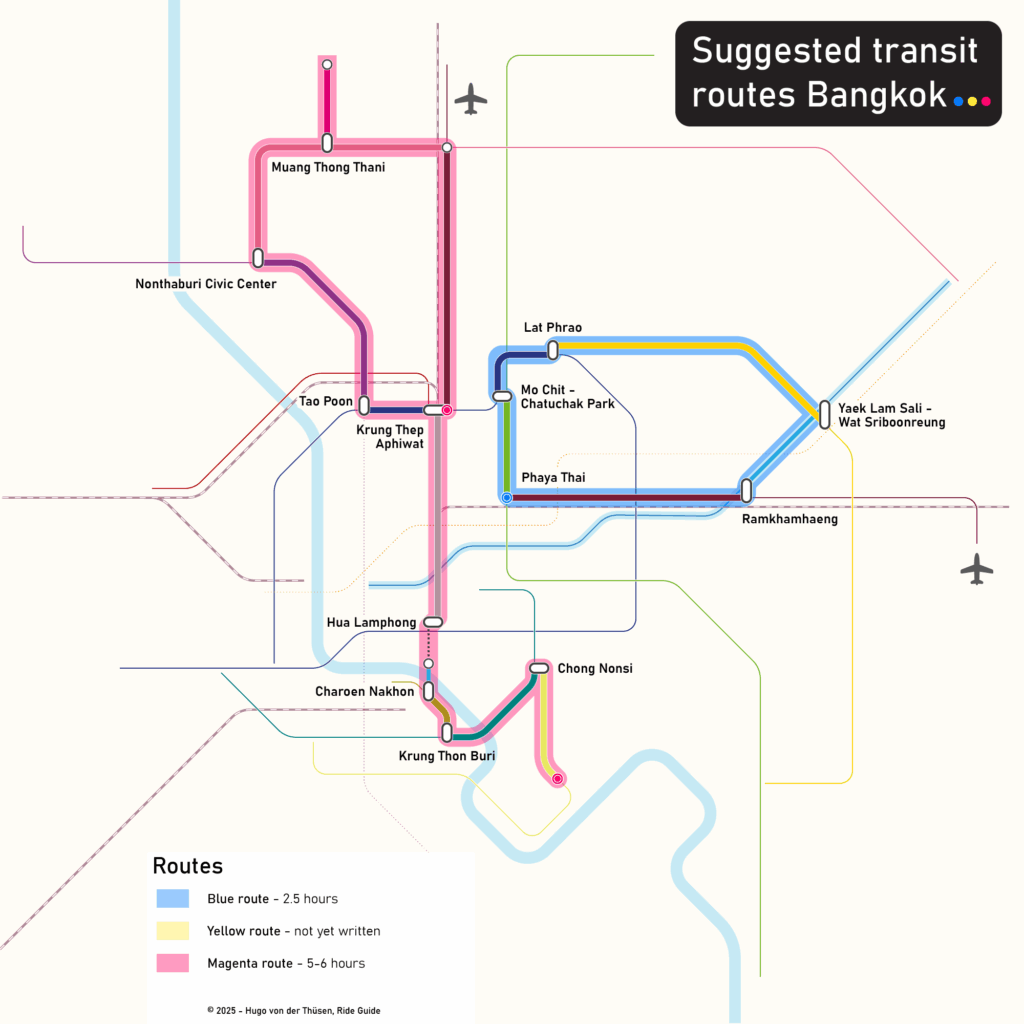Maps: Recommended, Urbanrail.net, Official
Bangkok is a city of over 9 million people (17M in metro area) and it is the most visited city by foreign tourists in the world so you would expect a seamless transit system. Instead, Bangkok offers a patchwork of Skytrains, subways, monorails, airport links, canal boats and buses. This seemingly chaotic network makes it a frustrating but very interesting and fun system to explore if you can avoid the rush-hour.
Recommended routes
Depending on how much time you have and what you would like to see there are three routes I recommend you take. If you have only a few hours and would like to experience some unique modes that Bangkok has to offer, take the Blue Route which takes around 2,5 hours. On this route you will take the monorail, Khlong boat, both MRT and BTS and the Airport Rail for a good mix of Bangkok transportation.
For the full experience, take the Magenta Route which uses every mode in Bangkok including the local trains, the BRT and the people mover. Depending on the time of day this takes between 5 and 6 hours but can be split easily with lunch in Chinatown or shopping at the Iconsiam mall.

Quirks and general tips
- Interchange Frustration: Even when two lines seemingly meet on the map, signage is often minimal if those lines are operated by competing companies. Examples include Mo Chit ↔ Chatuchak Park and Asok ↔ Sukhumvit. Never assume it will be obvious.
- Ticketing is fragmented: Different operators (MRT, BTS, SRT) mean different payment rules. There is no unified system although the Rabbit card may give that impression. Even within the same operator the ticketing options can vary. Tip: always carry some cash and use the machines.
- Off-peak vs. Rush hour: We’ve all seen the images of Asian rush hours and it is no different in Bangkok. Expect to let multiple trains pass whilst everyone queues orderly waiting for an empty carriage. It’s fun to experience but try to avoid it if you can.
- High-speed canal boats: Don’t miss the Khlong! This is the high-speed canal boat running along one of the many canals in Bangkok. You will be amazed at the speeds and it’s an unforgettable ride for only a few Baht. Commuters use it too as it’s a very useful method of transportation and basically just a metro on water.
- Many different modes: Besides the standard above and below ground metro’s on steel rails, Bangkok also has two driverless monorail lines and a short, urban people mover. Besides this there are regional and local trains and a few different suburban railways fanning out from the city’s railway termini. And don’t forget the rubber wheels as the city is riddled with local buses and a single BRT line.
Lines at a glance

Nice ride

Worth a deviation

Transit must-do
Sukhumvit Line

As the first metro to open in Bangkok in 1999, the Sukhumvit Line shows how stations can be built with a low budget whilst giving great views of the city.
Silom Line

Similar to its larger brother, the Sukhumvit Line. The Silom Line extends across the river with lovely views and a connection to the Gold Line
Blue Line

Real high-capacity metro serving some useful touristic stops. Very crowded during rush hours. Connects to most other lines.
Purple Line
A true suburban line serving the North and connecting to the Pink and Blue lines. Future extensions will tunnel under the city centre.
Yellow Line

A monorail soaring above the streets of the suburbs. Some useful connections and fun to ride in the front or back.
Pink Line

Similar to the Yellow Line but further out. Has a 2-stop branch in the North to connect to an events venue.
Gold Line

A funky little people mover built to serve the large Iconsiam mall. Autonomous and good views of the city.
Airport Rail Link

Once an ambitious project now a crowded elevated metro. Interesting history and useful for getting to the airport. Makkasan station is worth a visit.
Khlong

Absolute must-do. High-speed boats ripping through the canals and making stops of less than 5 seconds. Low prices and genuinely useful connections which makes it busy at rush hour. Basically a metro on water.
BRT

A quiet, underrated line gliding past traffic on its own lanes. Cheap, air-conditioned, and connects to the Silom Line. A glimpse of an idea that never fully took off.